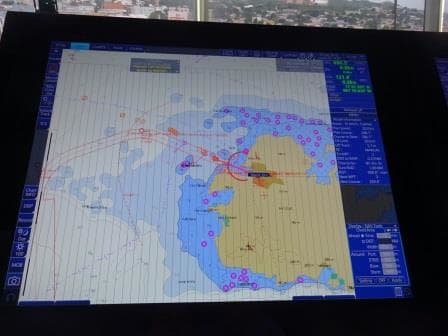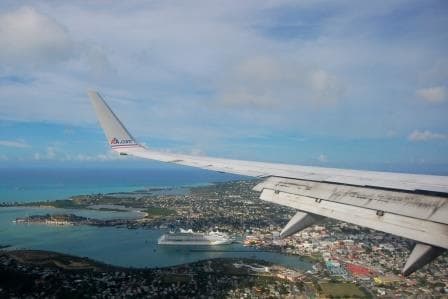Sailing into St. Johns Antigua is bit more complicated than sailing into Charlotte Amalie where the water is deeper and there is more room to swing. St. Johns lies deep in a natural bay but it is a very shallow bay. Almost so shallow that by the time you dock, there is hardly any water left under the keel. Regular dredging is taking place and they were doing so today as well; using the soil for shoring up the shore.
Coming from deep sea the ship approaches the pilot station and at once the depth gets a lot less. But still good progress can be made with 10 to 15 feet under the keel. Still the speed into port is then regular between 10 and 12 knots. You can try to go faster but the ship simply will not do it as the displaced water needs the time to flow away from under the keel. Then when coming to the dock the water depth is reduced to 5 feet or less at some places and then the ship becomes really sluggish in handling. Again because the water which is pushed away by the ship needs time to flow under and around the hull. Increasing power on the bow thrusters and Azipods does not help very much because of this delay. If you give too much power and the water starts flowing then you might overshoot (or bump into the pier) and have to counter act again. The lecturer at my Maritime Academy always said; it is like a very small man dancing with a very big lady, you have to guide, you cannot force, as then you lose control when the lady starts to sway over the dance floor.

White is deep water and the bluer it gets the more shallow it is. This shot of the electronic charts shows the departure route for this evening.
Thus the docking took some time today; the ship had to be inched forward slowly but steadily as the heritage pier where we docked ends up straight into the town center and thus you do not want to overshoot. Guests on deck could see the sand billowing in the water all around the ship indicating that there was not much clearance left under the keel. This evening when we sail out, we will have the same thing again, it will be a slow maneuver in the basin. First because the basin is not much longer than the length of the ship, and secondly during the 180 turn all that water on the port side that is being pushed away has to flow to the starboard side to fill the void.
St. Johns has two finger piers and can accommodate 4 mega ships if needed. Today we only had the Regal Princess in with us but together we brought just short of 6000 guests ashore so enough for the shopkeepers to be happy. The Regal Princess is much bigger than us but does not have that much more draft as the ship is wider. If you need stability for a box of a certain size, you need a certain amount of weight inside. Think about a tin can in your bath tub. No water inside and it can easily fall over. Fill it up and it sinks. Fill it so that it is level with the outside water level and it nicely bobs up and down in the tub. The same principle goes for the ships. They higher they go, the less weight there is in the lower part. So they can fall over. If you put more ballast in the bottom, they will become stable but the draft increases. If you make the ship wider, you can put the same amount of ballast in but divided over a larger area and the draft will not increase. That is one of the reasons why large ships such as the Oasis of the Seas do not fall over while they are much higher than other big cruise ships.

Rat Island is to the far left. We used to dock there with the ss Rotterdam who with 32 feet draft could not get to downtown.
If a ship has too much draft and you still want to go to St. Johns it can dock at Rat Island at the beginning of the bay but that is a long trek into town for the guests. This hardly happens anymore and now it is mainly a cargo terminal. Containerships dock here and today there was a Japanese Car Carrier, no doubt delivering new Japanese cars.
Tonight we will make the hop to St. Lucia and we will feel the same movement as last night. Nice and steady ship and then each time when it came out of the lee of one of the islands, the light swaying of the ship on the ocean waves until it came in the lee again of the next islands. We will pass Guadeloupe, Martinique and Montserrat so will gently roll several times. Tomorrow we will be in Castries St. Lucia where they are forecasting rain again, which we have hardly seen since San Juan and so we will just wait and see. Temperatures will be the same again 84oC / 29oC.

Leave a Reply